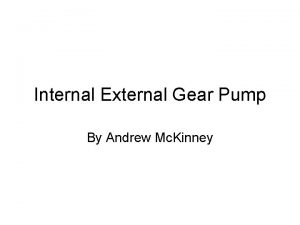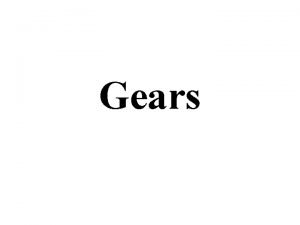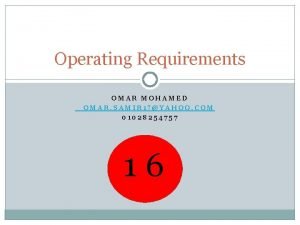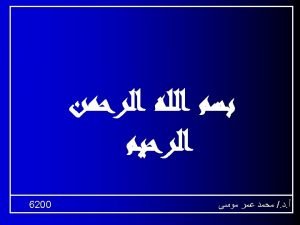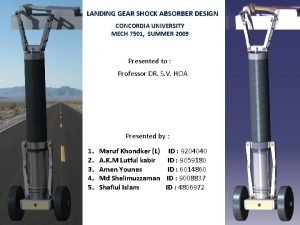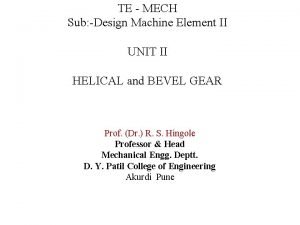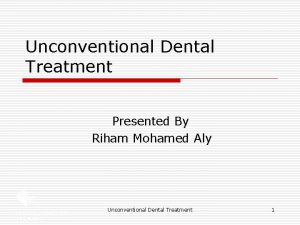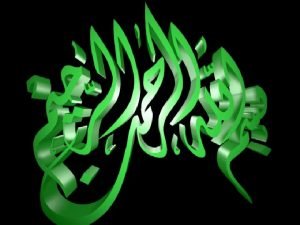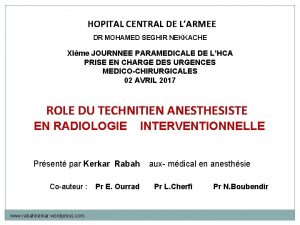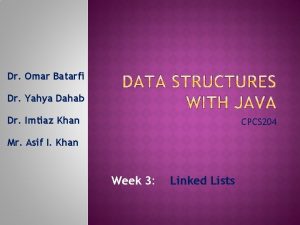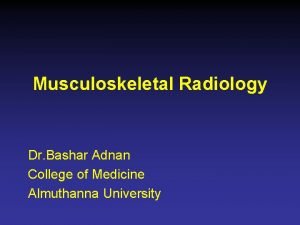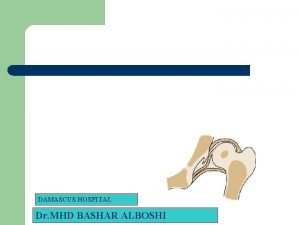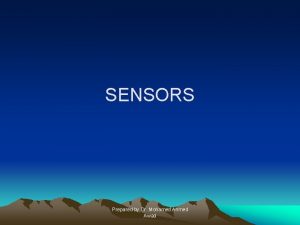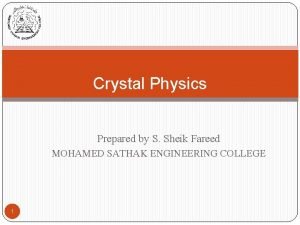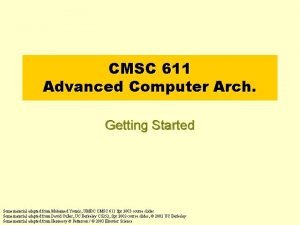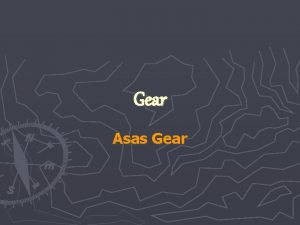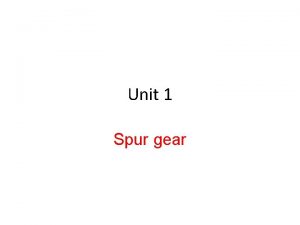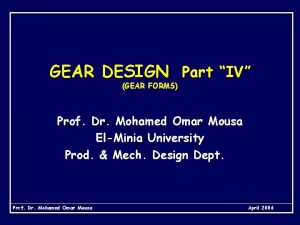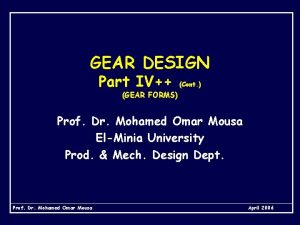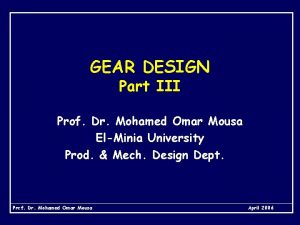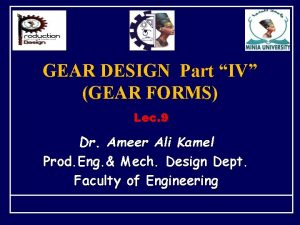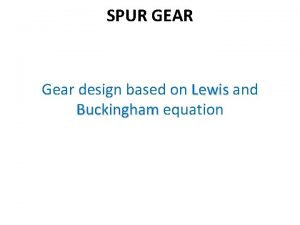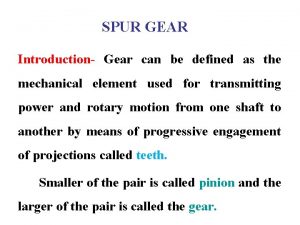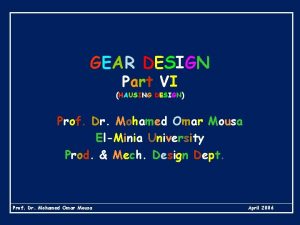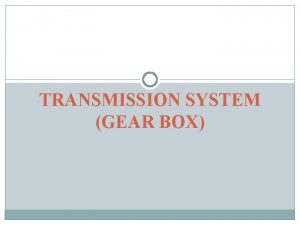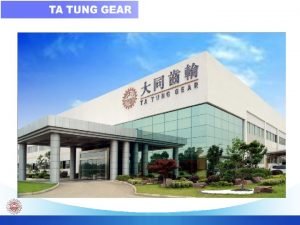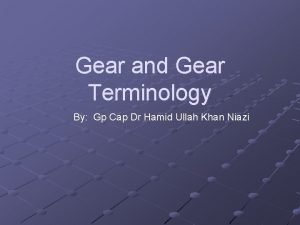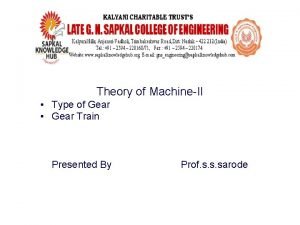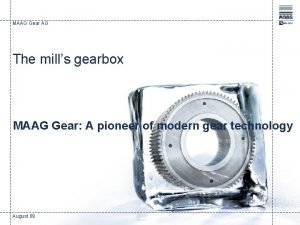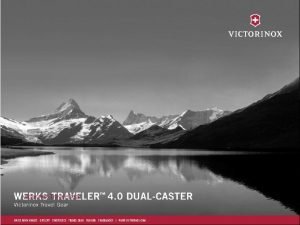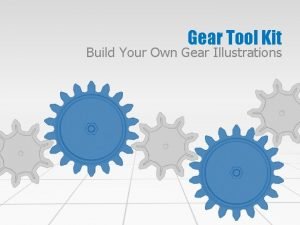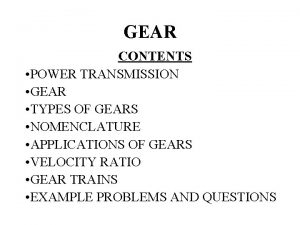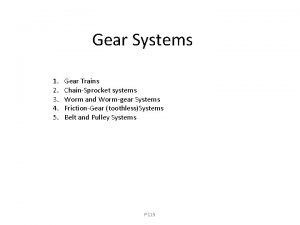GEAR DESIGN Part I INTRODUCTION Prof Dr Mohamed

































- Slides: 33

GEAR DESIGN “Part I” (INTRODUCTION) Prof. Dr. Mohamed Omar Mousa El-Minia University Prod. & Mech. Design Dept. Prof. Dr. Mohamed Omar Mousa April 2006

1. INTRODUCTION Gears are considered as mechanical elements, by which the contact surfaces are provided with grooves that prevent slip and ensure pure transmitting rotation. Gears are used as speed converters when a constant speed ratio between two axis with high accuracy is required. However, gears are used if the center distance between the shafts is relative small. But, it is important to notice that, gears required special equipment for manufacturing and no machining error is allowable by gear cutting. Prof. Dr. Mohamed Omar Mousa April 2006

Different kinds of gear are usually used in the engineering machinery branches. These types are: 1. External spur gears Gear ‘A’ is called the ‘driver’ because this is turned by a motor. As gear ‘A’ turns it meshes with gear ‘B’ and it begins to turn as well. Gear ‘B’ is called the ‘driven’ gear. Prof. Dr. Mohamed Omar Mousa April 2006

Design- Spur Gear Animation Prof. Dr. Mohamed Omar Mousa April 2006

A Gear Train is usually made up of two or more gears. The driver in this example is gear ‘A’. If a motor turns gear ‘A’ in an anticlockwise direction; the gear ‘C’ turns anticlockwise too. Prof. Dr. Mohamed Omar Mousa April 2006

The expressions ‘driver’ gears, ‘’driven’ gears and gear trains are explained. An ‘idler’ gear is another important gear. In the example opposite gear ‘A’ turns in an anticlockwise direction and also gear ‘C’ turns in an anticlockwise direction. The ‘idler’ gear is used so that the rotation of the two important gears is the same. Prof. Dr. Mohamed Omar Mousa April 2006

Compound Gear System Compound gears are used in engines, workshop machines and in many other mechanical devices. In the diagram, gear ‘A’ is actually two gears attached to each other and they rotate around the same centre. Sometimes compound gears are used so that the final gear in a gear train rotates at the correct speed. Prof. Dr. Mohamed Omar Mousa April 2006

2. Internal spur gears Gear system can be internally meshed. The inter gear can be denoted as wheel and the other is the pinion. In general, spur gears transmit power between parallel shafts. Prof. Dr. Mohamed Omar Mousa April 2006

3. Helical Gears Some gear systems have inclined tooth to increase the tooth width with respect to the gear width (i. e. , increase the load carrying capacity). . Prof. Dr. Mohamed Omar Mousa April 2006

4. Rack & Pinion It is still composed of two gears. The ‘pinion’ is the normal round gear and the ‘rack’ is straight or flat. Rack and pinion converts rotational motion into linear motion. Prof. Dr. Mohamed Omar Mousa April 2006

5. Bevel gears can be used to change the direction of drive in a gear system by 90 degrees. Desig 37 - Bevel gears animation Prof. Dr. Mohamed Omar Mousa April 2006

A good example is seen as the main mechanism for a hand drill. As the handle of the drill is turned in a vertical direction, the bevel gears change the rotation of the chuck to a horizontal rotation The bevel gears increase the speed of rotation of the chuck and this makes it possible to drill a range of materials. Prof. Dr. Mohamed Omar Mousa April 2006

Types of Bevel Gears A. Straight bevel gear B. Helical bevel gear Prof. Dr. Mohamed Omar Mousa April 2006

5. WORM GEARS The arrangement of gears seen is a worm and wormwheel. The worm, which in this example is brown in colour, only has one tooth but it is like a screw thread. The worm-wheel, coloured yellow, is like a normal gear wheel or spur gear. Design- Worm Gear animation Prof. Dr. Mohamed Omar Mousa April 2006

The gear ratio of a worm gear is worked out through the following formula: number of teeth on worm-wheel number of teeth on worm The worm acts as a single toothed gear so the ratio is; number of teeth on worm-wheel 1 Prof. Dr. Mohamed Omar Mousa April 2006

Examples of Worm wheel drives Prof. Dr. Mohamed Omar Mousa April 2006

The shown system is used to control a set of traffic lights. The mechanism involved includes a motor which drives a worm gear round, turning a wormwheel and the attached cam. As the cam rotates it hits a micro switch which turns on a light Prof. Dr. Mohamed Omar Mousa April 2006

Gear Train Any combination of gear wheels employed to transmit motion from one shaft to the other and is called gear train. The motion can be: A. Rotation between two parallel shafts (spur or helical gears). B. Rotation between two perpendicular shafts (Bevel gears). C. Rotation from one shaft to linear movement to the other (Rack & Pinion) Prof. Dr. Mohamed Omar Mousa April 2006

D. Rotation between two shafts with high speed ratio (Worm gear). Gear trains can be classified into: A. Simple trains of gears. B. Compound trains of gears. C. Reverted trains of gears. D. Epicyclic trains of gears Design 38 - examples of transmissions Prof. Dr. Mohamed Omar Mousa April 2006

A. Simple gear trains Wheels ‘A’ and ‘B’ constitute a simple gear train and rotate in opposite directions. Therefore, v Angular velocity. NA NB N Number of revolutions. Z Number of teeth. D Gear diameter. Prof. Dr. Mohamed Omar Mousa April 2006

Simple gear train may be constituted by more than two gears. as in the following figure. NA Prof. Dr. Mohamed Omar Mousa NB NC April 2006

It is important to notice that the third wheel ‘C” rotates in the same direction of the first wheel ‘A’. The second wheel is known as the idler wheel. For a simple gear train with “n” wheel, the speed ratio can be described as follows. Prof. Dr. Mohamed Omar Mousa April 2006

B. Compound Gear Trains 1 3 4 2 1 2 3 4 In compound gear train, two wheel ‘ 2 & 3’ are mounted in the same shaft and rotate together at the same speed. Prof. Dr. Mohamed Omar Mousa April 2006

3 1 4 2 1 Prof. Dr. Mohamed Omar Mousa 2 3 4 April 2006

C. Reverted Gear Trains Reverted gear train is a train in which the first and last gears are on the same axis. Therefore, it is used as speed reducer. 3 4 2 1 The following points should be considered: Where, R is the pitch circle radius. Prof. Dr. Mohamed Omar Mousa April 2006

3. Epicyclic Gear Train In the discussed gear trains, the wheels rotates about their axis. In the epicyclic gear train, a wheel ‘B’ rotates about other axis ‘Axis of gear ‘A’ where the wheel ‘A’ is fixed to the frame. The arm ‘C’ revolves carrying with it wheel ‘B’. B C A Epicyclic gear train is also called “Planetary Gears” Prof. Dr. Mohamed Omar Mousa April 2006

Velocity ratio of Epicyclic Gear Train Operation Arm ‘C’ Gear “A” Gear “B” Arm “C” locked 0 +1 -(ZA/ZB) Multiply by “x” 0 +x -(ZA/ZB)x Add “y” y y+x y-(ZA/ZB)x B C A 1. (-)ve sign for gear ‘B’ for the direction of motion. 2. As gear ‘A’ is fixed, therefore, y+x = 0 3. A useful assumption is that arm ‘C’ revolves one revolution. Prof. Dr. Mohamed Omar Mousa April 2006

Prof. Dr. Mohamed Omar Mousa April 2006

EXAMPLE C=35 B=20 E=20 F=30 A D=15 In the shown arrangement, wheel ‘E’ wheels ‘C’ and ‘D’ are integrated cast shaft (pin). If the arm ‘A’ revolves 1 clockwise, determine the speed and rotation of wheels ‘B’ and ‘F’ Prof. Dr. Mohamed Omar Mousa is fixed and on the same rpm counterdirection of April 2006

SOLUTION B=20 C=35 E=20 F=30 A D=15 Operation A B D&C E F Arm’A’ locked 0 1 -20/25 (20/15)(35/20) -(20/15)(35/20)(20/30) Multiyply by x 0 X -(20/25)x (20/15)(35/20)x -(20/15)(35/20)(20/30)x Add y Y x+y y -(20/25)x Y+ (20/15)(35/20)x y-(20/15)(35/20)(20/30)x As ‘E’ is fixed, Arm ‘A’ makes one revolution counter clockwise y=-1 Prof. Dr. Mohamed Omar Mousa April 2006

Solving the last two equations, Therefore, x = 3/7 Speed of ‘B’ is given by: x + y = (3/7) – 1= - 4/7 = -0. 572 i. e. , ‘B’ rotates 0. 572 rpm in the same direction of the arm i. e. , counter clockwise. Similarly, the speed of ‘F’ is given by: Y-(14/9)x = -1 -(14/9)(3/7) = -5/3 = -1/666 Prof. Dr. Mohamed Omar Mousa April 2006

2. GEAR REQUIREMENTS Gearing should meeting the following requirements: 1. Teeth must have a profile, which ensures a constant velocity. 2. The relative motion of one teeth on another should be more of a rolling nature than of a sliding motion. 3. The arc of engagement should be so long that, at all times, more than one pair of teeth are in mesh. In practice, this is not always fulfilled. Prof. Dr. Mohamed Omar Mousa April 2006

EN D Prof. Dr. Mohamed Omar Mousa April 2006
 Crescent type oil pump
Crescent type oil pump Introduction of gears
Introduction of gears Mohamed samir design
Mohamed samir design Mohamed samir design
Mohamed samir design Landing gear shock absorber design
Landing gear shock absorber design What is virtual number of teeth
What is virtual number of teeth Riham mohamed aly
Riham mohamed aly Mohamed dahoui
Mohamed dahoui Dr elsayed mohamed
Dr elsayed mohamed Mohamed kossentini
Mohamed kossentini Mohamed homayed
Mohamed homayed Discovering computer
Discovering computer Mohamed el merouani
Mohamed el merouani Mohamed seghir nekkache
Mohamed seghir nekkache Mohammad diab md
Mohammad diab md Yahye mohamed omar
Yahye mohamed omar Professor nasser mohamed
Professor nasser mohamed Dr mohamed eldeib
Dr mohamed eldeib Mohamed
Mohamed Bouhicha mohamed
Bouhicha mohamed Abdelrahman mohamed
Abdelrahman mohamed Dr mohamed bashar shala
Dr mohamed bashar shala Dr alboushi
Dr alboushi Mohamed salah
Mohamed salah Mohamed akel
Mohamed akel Mohamed akel
Mohamed akel Mohamed akel
Mohamed akel Zahran nyu
Zahran nyu Henintsoa georges
Henintsoa georges Parallel computing nyu
Parallel computing nyu Mohamed merchant
Mohamed merchant Mohamed akel
Mohamed akel Point defects in crystals
Point defects in crystals Mohamed younis umbc
Mohamed younis umbc
